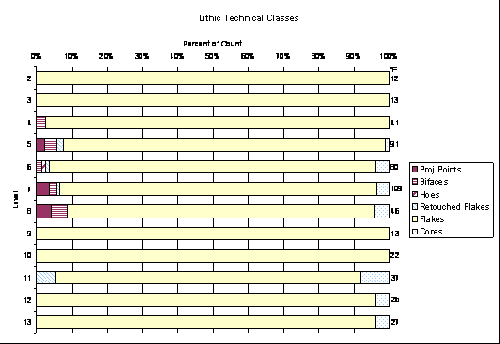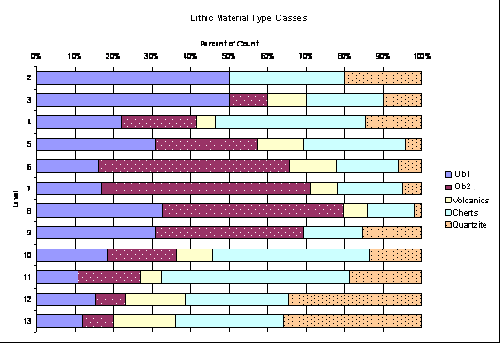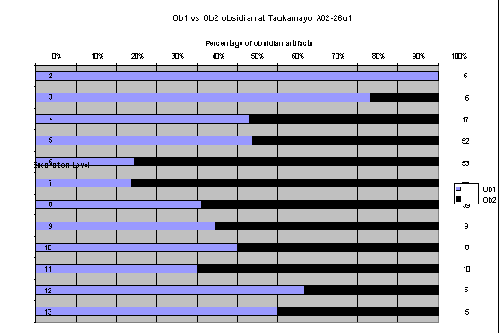Artifacts by level
Obsidian arrives into the test unit area in conjunction with bones, both burned and unburned, that turned out to be primarily camelid bones. The lithic analysis evidence suggests that obsidian was brought into the area around level 8 where the mean flake size is considerably higher than average and obsidian goes from an average 55% of the lithic assemblage by level, to 80% of the assemblage in level 8 and then 70% of the assemblage in level 7.
|
Obsidian |
Non-obsidian |
||||||
|
Level |
Possible Bifacial Thinning |
No. |
Ave. Rotations |
Ave. Cortex |
No. |
Ave Rotations |
Ave Cortex |
|
2 |
5 |
0 |
0 |
5 |
0 |
18.0 |
|
|
3 |
6 |
0 |
0 |
4 |
0 |
17.5 |
|
|
4 |
17 |
0.4 |
1.2 |
24 |
0 |
7.9 |
|
|
5 |
6 |
51 |
0.6 |
1.6 |
39 |
0.2 |
4.9 |
|
6 |
2 |
53 |
0.3 |
1.5 |
27 |
0.4 |
9.6 |
|
7 |
7 |
79 |
0.3 |
1.8 |
32 |
0.1 |
3.4 |
|
8 |
1 |
38 |
0.3 |
4.7 |
10 |
0 |
7.0 |
|
9 |
1 |
9 |
0.3 |
0 |
4 |
0 |
2.5 |
|
10 |
8 |
0.1 |
0 |
14 |
0.2 |
7.1 |
|
|
11 |
10 |
0.3 |
6.0 |
27 |
0.3 |
12.2 |
|
|
12 |
6 |
0.5 |
8.3 |
20 |
0.2 |
15.0 |
|
|
13 |
5 |
0.2 |
2.0 |
20 |
0.2 |
15.5 |
|
|
Total |
17 |
287 |
0.3 |
2.2 |
226 |
0.2 |
9.0 |
Table 7-32. A02-26u1: Artifact counts and averages for select measures.
|
Proj Points |
Bifaces |
Cores |
Retouched Flakes |
Flakes |
Total |
|
|
Level |
No. |
No. |
No. |
No. |
No. |
|
|
2 |
10 |
10 |
||||
|
3 |
10 |
10 |
||||
|
4 |
1 |
40 |
41 |
|||
|
5 |
2 |
3 |
1 |
2 |
82 |
90 |
|
6 |
1 |
3 |
1 |
75 |
80 |
|
|
7 |
4 |
2 |
4 |
1 |
100 |
111 |
|
8 |
2 |
2 |
2 |
42 |
48 |
|
|
9 |
13 |
13 |
||||
|
10 |
22 |
22 |
||||
|
11 |
3 |
2 |
32 |
37 |
||
|
12 |
1 |
25 |
26 |
|||
|
13 |
1 |
24 |
25 |
|||
|
Total |
8 |
9 |
15 |
6 |
475 |
513 |
Table 7-33. A02-26u1: Lithic Technical Classes by Level showing counts.
Figure 7-38. A02-26u1 Technical Class by Excavation Level.
Figure 7-39. A02-26u1 Material Types by Excavation Level.
Figure 7-40. Obsidian at Taukamayo A02-26u1, Ob1 and Ob2 compared.
Material types at Taukamayo provide insights regarding the use of non-obsidian lithic material in the vicinity of the Chivay source. Chert is abundant in the Colca and the Llapa rivers, and in Taukamayo creek. Yet the reduction in imported obsidian appears to have occurred at a few distinct sites in the Upper Colca valley area, as if complementing the local chert use.
The use of Ob1 and Ob2 obsidian at Taukamayo is also informative. The influx of obsidian in levels 6-8 appears to have been from a source with Ob2 obsidian as both types of obsidian increase in these levels but the percentage of Ob2 obsidian is significantly greater than it was in previous and later levels. In the course of survey work, Ob2 obsidian was encountered outside of the Maymeja zone in Block 4, and also at a minor obsidian source in the Pulpera drainage called Condorquiña (Section 4.5.1). It is possible that the Ob2 obsidian was derived from one of these sources, and that this lower quality obsidian was generally not intended for projectile point production. In fact, projectile points are comparatively rare at Taukamayo, with only 8 obsidian projectile points and preforms coming from the TU1 pit, and of these only one point (in level 7) was Ob2 material. This evidence suggests that the focus on obsidian production in this area in the beginning of the Middle Horizon was on flake and biface production, and there was relatively little preference shown for Ob1 obsidian over Ob2 material.
In level 5, there appears to have been more advanced reduction of obsidian occurring. The BTF index suggests that bifacial thinning flakes are more prevalent than in other levels, and 3 broken bifaces (50% of total) were found in level 5, the average number of rotations went from 0.36 to 0.56 in level 5 implying that greater conservation of material was occurring in that level.
Figure 7-41. Cumulative frequency comparing obsidian and non-obsidian flakes.
Levels 5 and 6 also contained a high density of animal bone. Analysis of diagnostic faunal remains by Randi Gladwell revealed that the majority of the bones were camelid, and though some small mammal bones were encountered that may have been cuy(guinea pig) or viscachabones. Comparing obsidian with non-obsidian overall, it is apparent that more advanced reduction occurred on obsidian. This contrast is expressed in Figure 7-41 where over 80% of obsidian flakes are under 1.7g in weight.




